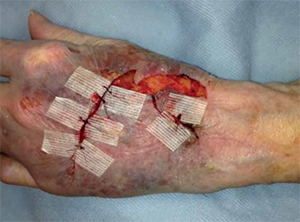
In 2012, Cornet et al published an excellent systematic review on oxygen administration in emergencies.7 They concluded that the outcomes in many disease entities are worsened by supplemental oxygen administration. Many conditions are worsened by the use of supplemental oxygen in patients without hypoxia: these include AMI, congestive heart failure, chronic obstructive pulmonary disease, and stroke.
Explore This Issue
ACEP Now: Vol 34 – No 01– January 2015
Figure 2. For my modification, I cut pieces of Steri-Strips for anchoring at key locations and sutured through them. Note that tissue loss and defect and significant tension did not allow for approximation of all wound edges.
Now, back to AVOID (Air Versus Oxygen In ST-elevation MyocarDial Infarction). Perhaps this is the trial that the Cochrane crew was looking for. In it, 638 patients with suspected STEMI (441 confirmed) were randomized to no oxygen (unless SaO2 <94%) or 8 L/min via simple face mask. The primary end point was infarct size (good choice), but the measure of infarct size was total creatine phosphokinase (CPK) and troponin I (surrogate markers). Biomarkers do predict AMI, but their ability to accurately predict infarct size has been challenged.8 A redeeming feature of the study was the confirmation of increased myocardial damage at six months via cardiac MRI.
Other limitations include the use of 8 L/min oxygen for the treatment group. In general, 2–4 L/minute via cannula is more consistent with current U.S. practice. Finally, we have to recognize the limitation of pulse oximetry. Using pulse oximetry to estimate actual arterial oxygen tensions (I’m not suggesting the use of arterial blood gases) is akin to using bifocals to pick up a grain of salt. For instance, a pulse oximetry range between 92 percent and 96 percent will likely have a much larger range of arterial oxygen tension associated with it. The vasoactive effect that oxygen has on chemoreceptors is a microscopic phenomenon.
Despite the fact this study, and many before it, have had limitations, we have forgotten one thing—common sense. I think we can stop studying this concept. Although perhaps the scientist in all of us longs for that one definitive study, we are victims of paralysis by analysis. We have enough evidence to conclude that giving this drug to people without a demonstrated need (eg, hypoxia) provides them no benefit and may, in fact, cause harm.
Oxygen is a vasoactive drug. This is an indisputable fact. Give this drug to patients who don’t need it, and whether you can prove it with scientific rigor or not, you will eventually hurt people.
Alcohol Levels: What Question Are You Asking?
Some tests have their utility stretched beyond rational use. Blood alcohol levels are frequently ordered but have limited clinical value, and such ordering patterns are validated and encouraged with positive results. I think we have collectively forgotten what questions we need to ask and what the right test(s) is to find those answers. Alcohol levels may be important when we are determining the source of an altered mental status, but when the source is clear, why order it? For instance, a negative ethanol level in a patient with minor head trauma should point the diagnostic compass immediately toward intracranial injury, but when patients say they drank a six-pack, you can smell it, and they appear intoxicated, does your laboratory really need to confirm the presence of alcohol? If confirmation is warranted, why not a breathalyzer? If you say you’re drunk, your breath says you’re drunk, and I think you’re drunk, you’re drunk.
Pages: 1 2 3 4 5 | Single Page





2 Responses to “Sutures for Skin Tears, Oxygen Therapy for STEMI Patients, and Blood Alcohol Levels to Assess Intoxication: More Myths in Emergency Medicine”
February 8, 2015
Derek McCalmontDr. Klauer incorrectly states that the level of blood alcohol for legal intoxication varies from state to state. Laws and penalties vary but the level of .08 is universal across all 50 states.
At what point does Dr. Klauer propose discharge for intoxicated patients without family or friends to assume care in the absence of a blood alcohol level?
February 19, 2015
suture through Steri-strips | DAILYEM[…] ACEP Now article + pictures; original 2011 article for idea […]